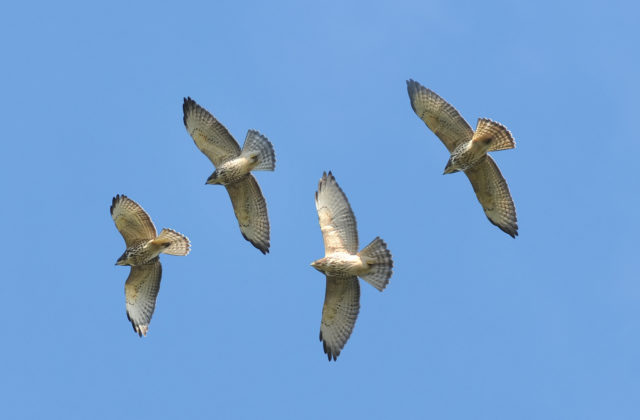Catching the Annual Fall Migration of Hawks
By Jude Mead
Witnessing firsthand the sight of hundreds, thousands or even tens of thousands of hawks flying overhead during their fall migration to South America is an extraordinary experience. Those that have seen this spectacle say it is the event of a lifetime, and Ayrslea Denny can attest to that.
Denny has been a birder since childhood, but her interest in hawk migration began in the early 1970s when she moved to Norfolk. She soon joined the Sharon Audubon Center and was introduced to her first hawk migration watch on Mount Riga. Since then Denny has visited many hawk watch sites in the area, including her latest visit several weeks ago to Chestnut Hill in Litchfield. “It was amazing. We spotted two thousand broad-winged hawks and five bald eagles within four to five hours time,” she said.
Hawks migrate at different times during the fall, and Denny says that, if she’s lucky, she will get to see the migrations.“Sharp-shinned hawks, Cooper’s hawks, kestrels, harriers and red-tailed hawks migrate in October and travel in groups. Eagles, both golden and bald, like to migrate alone in late September or October,” she says. It is the broad-winged hawk, though, that is most often seen. They begin their annual southward migration in September and continue through the month. According to Denny, September is the peak time to see them, when the weather conditions are just right. “So much of the migration depends on the weather.”
Wind is a major factor affecting what you see at any hawk watch site. Denny said a good flight day for a hawk would be one with northwesterly winds. She added that each species, however, is affected differently by the speed of the wind. “Most hawks, like the broad-winged hawk, like moderate to weak winds coming out of the northwest. These winds are best for migratory activity.”
Hawks migrate best after the arrival of a high-pressure system when the sun heats the earth, causing a thermal or upward current of air to develop. The thermal helps lift the birds to higher altitudes where they can travel for miles with very little effort. “Birds can ride the thermal and not have to flap their wings. They just glide until they get to the next thermal. This way they can cover many miles in a day without tiring,” said Denny.
Broad-winged hawks are noted for their large migratory flocks and are often seen at hawk watches in the area. They can be identified by their distinctive coloring and wingspan. They are brown on top and white underneath with a wingspan about three feet long. Denny described a recent experience where she viewed thousands of broad-winged hawks. “These hawks usually travel in large groups called kettles. A kettle is a swirling mass of birds in the sky looking for thermals in order to gain altitude. The number of hawks in a kettle can range from ten to a thousand. As they travel higher they appear as specks in the sky,” she said.
These thermals not only help the broad-winged hawk sustain a long-distance flight but also help bird counters record the number of them migrating. Thermals can only go so high, and when the hawks get to the top they cannot gain any more altitude. “This is when they peel off and find the next thermal. It is also when we get to count them,” said Denny. She explained that as the birds stream off the thermal for a short time, they are all going in the same direction, making it easier to get a more accurate count. “It takes some experience to count hawks, but you quickly get to know what a group of ten or twenty looks like.”
Though it is only an estimate, Denny said keeping a count of hawks is important because they sit at the top of the food chain, which makes them an early-warning system for the environment. Getting a count also allows conservationists to use this resource as a marker to see if there is any decline in population.
“The best example of how counting birds helped a species was when years ago the bald eagle population dropped,” said Denny. Apparently, the widespread use of the pesticide DDT had entered the food chain of the eagle, making their eggshells too thin for chicks to survive. By keeping a bird count, scientists were able to demonstrate the decline in population, get DDT banned and reintroduce the eagle before it became extinct.
What began as a leisurely activity for Denny has turned into a full-time passion. Over the years she has gained a wealth of knowledge about birds and birding and is always willing to share what she has learned. She even has tips for new hawk watchers. “First get a good pair of binoculars. Then find a location close to where an official hawk count takes place. It’s good to be with experienced hawk watchers to help identify the different species,” said Denny. She added that a chair, warm clothes and a hat also help.
What she recommends most, though, is to not to get discouraged. “Initially, many days were not successful, and I wondered why I was still sitting there. When I do get to see the migration, however, it is really worth the time,” she said. Denny suggests grabbing those binoculars and heading to Chestnut Hill in Litchfield or Blueberry Hill in Granville, Mass. With any luck you will catch the hawks migrating.
Photo of broad-wing hawks in flight by Jerry Jourdain.

